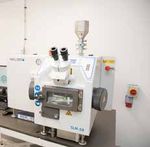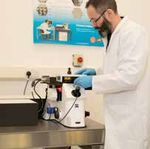Additive Research Laboratory - Amber
←
→
Page content transcription
If your browser does not render page correctly, please read the page content below
Additive Lithoz Nanoscribe
Research Cerafab Photonics
Laboratory 7500 Professional GT
A ceramic additive manufacturing A highly specialized stereolitho-
The AR-Lab will be a pivotal component of AMBER’s
tool – the first of its type in Ireland, graphy tool, capable of 3D printing
research focussed on the fundamental material science and specifically modified for AMBER a range of UV curable polymers from
challenges associated with 3D printing. We have invested to be the highest resolution tool of sub-millimetre down to nano-scale
in a purpose built suite of 3D printing technology which its type in the world. It is capable of dimensions. Feature sizes at these
spans the full spectrum of materials from ceramics and 3D printing a wide range of advanced lower dimensions will enable
engineering, and biomedical grade research into applications such as
metals to polymers and biomaterials. This investment will
ceramics into highly complex photonics and optics, bioengineering,
play a leading role in the emerging 3D printing national geometries. Historically, technolo- bio-mimetics, micro-fluidics,
research ecosystem. It will enable AMBER to build on our gies available to process ceramics interfacial surface interactions
foundation of research excellence in materials science into complex shapes, particularly at and metamaterials.
to become leaders in this emerging technology which is small dimension feature sizes, have
been limited by material fragility.
critical to a variety of sectors within Ireland including
Applications using this technology
medical devices, manufacturing technologies and include (but are not limited to) bone
electronic devices. implants, high temperature/wear/
corrosive environments, space and
AMBER is already collaborating with a number of aerospace and communications
technologies.
companies in these areas as they seek to exploit these
exciting technologies. AMBER’s AR-Lab has and will
enable new partnerships and collaborations between
AMBER and innovation-led SMEs and multinationals. It
will also drive new international collaborations in next
generation material sets for additive manufacturing with
leading universities and research centres.
The AR-Lab has been enabled by a €3.3M award from
Science Foundation Ireland as part of their Research
Infrastructure program and an additional €1M investment
from the European Research Council through our world
leading investigators.
AMBERRealizer 3D Systems Optomec MicroDrop
SLM ProX AerosolJet Autodrop
50 DMP200 300 System Gantry
The highest resolution conventional This metal powder bed SLM This is a printing platform uniquely A bespoke ink-jet platform again
metal powder bed selective laser tool – the first one of its type in specified for spatially depositing matched for use for the deposition
melting (SLM) tool available on the Ireland – was originally developed AMBER’s bespoke liquid exfoliated of AMBER’s bespoke nano-material
market and the first one of its type for the processing of dry powdered nano-materials, that form the inks. This tool is complementary to
in Ireland. It is capable of 3D printing ceramics. This unusual capability backbone of research for Professor the AerosolJet platform above, for
the broadest range of conventional increases the flexibility of the tool Jonathan Coleman’s European the same research purposes — but it
SLM powdered metal alloys, some for processing very fine and non- Research Council (ERC) Advanced has the additional capability of being
precious metals, but particularly regular metal powders (those doped award into nano-ink printed a precision micro-fluidic instrument
metals for the design of bone with nanomaterials for example), electronics, and Professor Valeria that enables specific performance
implants. This system has been that may not be ‘optimised’ for use Nicolosi’s ERC Consolidator award figures of merit to be accurately
designed using an unusual laser on other, more conventional, SLM into 3D printing of nano-materials for correlated to nano-material devices
configuration which enables a high platforms. A knock-on benefit of this next generation energy storage. This across both platforms.
degree of flexibility and control of is a much wider design-form/shape piece of equipment is unique in the
alloy melt processing – exactly what envelope than many SLM tools, field world-wide due to its ability to
is required for bio-metal materials enabling applications in aerospace, co-print 2 nano-inks simultaneously
science research and delivering energy and bio-engineering where in continuously varying proportions
personal therapies to patients. the value proposition involves (“spatial grading”).
breaking form-function constraints.
The Optomec and MicroDrop are part of projects that
have received funding from the European Research
Council (ERC) under the European Union’s Horizon
2020 research and innovation programme under grant
agreement numbers 681544 and 694101Support Platforms:
Nikon Brabender Who is involved?
XTH225 KETSE 20/40
ST EC A number of AMBER’s Principal Investigators and technology leads
are driving research associated with 3D printing including:
This is an essential non-destructive A powerful and highly accurate
characterisation platform for polymer twin-screw compounder Prof Mick Morris
evaluating the shape/structure and -extruder. This is a materials- Prof Daniel Kelly
materials design properties of AM feedstock support platform for our Prof Garret O’Donnell
parts fabricated on the above tool- polymer fused filament fabrication Prof Rocco Lupoi
sets. Sequential X-ray images are AM capability, which will produce Dr Daniel Trimble
used to image completed AM parts bespoke polymer filaments to Dr Ramesh Babu
through 360 degrees. From this, support centre research into Prof Valeria Nicolosi
advanced graphical rendering and nano -composites, hierarchical Prof Jonathan Coleman
processing software can re-image co-polymers, bio-engineering
the part in 3-dimensions – down and filtration applications.
to 1 micron in minimal resolution. This will lead to new classes of
Qualitative and semi-qualitative printable polymers and so enable
information on defects, geometry, a broad use of this technology. Contact us
voids/inclusion, microstructure T EC HN ICAL ENQUIRIES:
TARA ST
STATION
and dimensional stability can be Richard Coull
TRINITY
COLLEGE
DUBLIN
obtained, which will inform the Lead Engineer
need for further higher resolution number of other bespoke tools are
A +353 (0) 87 965 8355
WESTL
AND RO
W AMBER
PEARSE
materials characterisation, available available in our other laboratories rcoull@tcd.ie STATIOST
N LOMBAR
D ST
in AMBER’s adjoining Advanced and we are happy to provide more
PEARSE ST
Microscopy Laboratory. detail on these as requested. AMBER AR-Lab
HANOVER ST
UNIT 7, Trinity Technology
ST
& Enterprise Campus, SAND
WITH
Grand Canal Quay,
RIVER LIFFEY
Dublin 2, Ireland ERNE ST
PEARSE ST
INDUSTRY RELATED ENQUIRIES:
Keith Alden
AR-Lab MACKEN ST
Business Development Manager
+353 1 896 3485 / 87 364 0382
keith.alden@tcd.ie TOWER GRAND CANAL
DESIGN SQUARE
CENTRE FORBES ST
GRAND CANAL QUAY
AMBER
HANOVR QUAY
GRAND
CANAL
CRANN Institute, BASIN
Trinity College Dublin,
Pearse Street, Dublin 2
AR–LabYou can also read
























































